
About UsThe Numismatic Bibliomania Society is a non-profit organization promoting numismatic literature. For more information please see our web site at coinbooks.org SubscriptionsThose wishing to become new E-Sylum subscribers (or wishing to Unsubscribe) can go to the following web page link MembershipThere is a membership application available on the web site Membership Application To join, print the application and return it with your check to the address printed on the application. Membership is only $15 to addresses in the U.S., $20 for First Class mail, and $25 elsewhere. For those without web access, write to: David M. Sundman, Secretary/TreasurerNumismatic Bibliomania
Society AsylumFor Asylum mailing address changes and other membership questions, contact David at this email address: dsundman@LittletonCoin.com SubmissionsTo submit items for publication in The E-Sylum, just Reply to this message, or write to the Editor at this address: whomren@coinlibrary.com
BUY THE BOOK BEFORE THE COINYou won't regret it! |
- WAYNE'S WORDS: THE E-SYLUM MARCH 28, 2010
- DOUGLAS SAVILLE NUMISMATIC BOOKS FIXED PRICE LIST AVAILABLE
- BRYCE BROWN'S COIN AUCTION CATALOGS WEB SITE UPDATE
- NEW BOOK: GOLD IN HIS VEINS: THE STORY OF JOHN DAGGETT
- NEW E-BOOK: THE ULTIMATE GUIDE TO CONDER TOKENS
- JEFFREY LAPLANTE'S CANADIAN COIN GUIDE REVIEW
- ANA LIBRARY STACK'S FAMILY LIBRARY AUCTION PURCHASES
- ANS LIBRARY STACK'S FAMILY LIBRARY AUCTION PURCHASES
- ANS DIGITIZATION PROJECT UPDATE
- COIN WORLD CELEBRATES 50TH ANNIVERSARY
- KRAUSE PUBLICATIONS
- MORE ON THE 1872 J.F. BELL PROOF EAGLE
- A FRENCH COIN CABINET C1809-19 BY JACOB-DESMALTER
- NOTES FROM E-SYLUM READERS: MARCH 28, 2010
- QUERY: WAS GILBERT STUART SKETCH THE MODEL FOR DRAPED BUST COINAGE?
- HISTORY OF THE CASINO CHIP & GAMING TOKEN COLLECTORS CLUB
- THE EMERGENCY MONEY COLLECTOR, VOL. 1 NO. 4
- MORE ON SHIRJIEH PUBLISHERS AND COPYRIGHTS
- COPYRIGHTS AND THE E-SYLUM
- MORE ON THE STOLEN VALOR ACT OF 2005
- A COMPULSIVE COLLECTOR: COIN HOARDS IN IRAN AND PAKISTAN
- NEWSPAPER ARTICLE PROFILES NUMISMATIC WRITER ED REITER
- FIRST EVER VICTORIA CROSS MEDAL TO BE SOLD
- JOHNNY SWING'S COIN FURNITURE
- FEATURED WEB PAGE: IN GOD WE TRUST COURT OPINION
WAYNE'S WORDS: THE E-SYLUM MARCH 28, 2010

Among our new subscribers this week are Patrick McBride (of Frederick, MD), courtesy of Pat McBride (of McKeesport, PA), Jeff Davidson, Brian Walker. Welcome aboard! We now have 1,330 subscribers.
Sorry for the late publication time - I was traveling this week and it was a struggle to keep up with all the material. I think we have another great issue, although my fingers are crossed with respect to the special characters we've had trouble with in the past. Hopefully the new fix will work for the entire issue.
We open with reports from literature dealers Doug Saville and Bryce Brown, followed by announcements and reviews of three new books. In other news we learn what the ANA and ANS libraries bought at the recent Stack Family library sale. Other topics this week include the model for Draped Bust coinage, casino chip collecting, and the first ever Victoria Cross medal.
To learn about the grouchy old man of numismatic writing, a Russian cannonball from the Crimean war, and Johnny Swing's Nickel Couch, read on.
Wayne Homren
Numismatic Bibliomania Society
DOUGLAS SAVILLE NUMISMATIC BOOKS FIXED PRICE LIST AVAILABLE
Fixed price list of interesting, but often inexpensive secondhand & out-of –print numismatic books
Upwards of 800 numismatic books, offprints, & extracts, offered for sale at fixed prices. Relating to ancient coinages, British coins & tokens, world coins & tokens and medallions; including some numismatic periodicals.
Including much interesting, and some obscure material, seldom offered for sale. Most items listed here are recently-purchased and have not been listed or offered for sale on my website - where approaching 1000 items on the subject are offered for sale.
To request a copy, contact Douglas by email at: info@douglassaville.com
BRYCE BROWN'S COIN AUCTION CATALOGS WEB SITE UPDATE
Numismatic literature dealer Bryce Brown of Connecticut writes:
Bryce Brown's Coin Auction Catalogs has a new website: brycebooks.squarespace.com/ .
My postal address and email contact information remains the same:
Bryce Brown
PO Box 16
Avon, CT 06001
numismatics@att.net
NEW BOOK: GOLD IN HIS VEINS: THE STORY OF JOHN DAGGETT
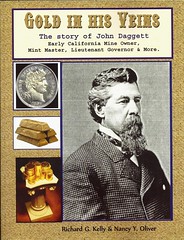 Our newest book, titled “Gold in his Veins…the story of John Daggett”, is now available.
Our newest book, titled “Gold in his Veins…the story of John Daggett”, is now available.
The book starts with how John Daggett sailed to California in early 1852 with the hope of discovering gold in the west and thence becoming a rich man. He left the small town in New York where he grew up with only a few dollars in his pocket but with a wealth of enthusiasm. When he got to California, what he found was a lot of competition for land in the gold mining areas, harsh mountain winters, disastrous lowland floods, strains of deadly diseases and a multitude of accidental deaths both in and around the mines. Nevertheless, he did eventually find gold – and lots of it!
Not only did John become a successful miner, and mine owner, but he also became a successful politician. And, his political achievements led to his being selected to the esteemed position of Superintendent of the San Francisco Mint. And, while he was superintendent, the mint produced one of its most collectable rarities today, the 1894-S dime.
It is obvious from John's stories that he enjoyed life and all it had to offer. Whatever he did he did with gusto, not always with success, but always with gusto. He prized a challenge and he made sure he was never without lots of them.
This book offers a look into the very full and rewarding life of John Daggett. It provides a look at how his political influence affected the history of the state of California – perhaps some for the better and perhaps some for the worse. How John's most successful mine “Black Bear” affected the very economy of the state and how his tenure as mint superintendent affected the hobby of numismatics.
You can get your copy by sending a check or money order for $21.95 ($3 off the cover price) to:
O.K. Associates
26746 Contessa St.
Hayward, CA 94545
Or, if you would like more information, email us at noliver146@sbcglobal.net.
NEW E-BOOK: THE ULTIMATE GUIDE TO CONDER TOKENS
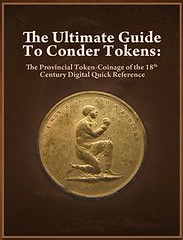 It's finally here...Introducing a remarkable digital numismatic reference for Conder Token collectors that has twice the utility of a hardcopy of D&H and is available at a fraction of the cost. We have successfully taken the “Bible” of 18th Century British Tokens, Dalton and Hamer's Provincial Token-Coinage of the 18th Century, ripped it apart and meticulously pieced it back together into a restructured, fully integrated digital book . . . adding oodles of info and a multitude of navigational features along the way to create the infinitely more user-friendly Conder token reference, The Ultimate Guide To Conder Tokens: The Provincial Token-Coinage of the 18th Century Digital Quick Reference.
It's finally here...Introducing a remarkable digital numismatic reference for Conder Token collectors that has twice the utility of a hardcopy of D&H and is available at a fraction of the cost. We have successfully taken the “Bible” of 18th Century British Tokens, Dalton and Hamer's Provincial Token-Coinage of the 18th Century, ripped it apart and meticulously pieced it back together into a restructured, fully integrated digital book . . . adding oodles of info and a multitude of navigational features along the way to create the infinitely more user-friendly Conder token reference, The Ultimate Guide To Conder Tokens: The Provincial Token-Coinage of the 18th Century Digital Quick Reference.
What's in it for the Novice? Everything! It's more than an extremely cost-effective alternative to buying a hard copy of D&H. It provides all of the essential content of D&H and the need-to-know facts about the original reference. Incorporates a discussion on rarity, token composition analysis, collecting tips, value study, and an excellent article on the history of the series courtesy of Professor George Selgin.
What's in it for the Connoisseur? A lot! Everything has been completely integrated and reformatted. Unique search-ability and tons of intra-document links make sifting through the hundreds of pages in D&H nearly effortless… and includes a price analysis to boot!
For more information, see: www.ConderTokenBook.com
JEFFREY LAPLANTE'S CANADIAN COIN GUIDE REVIEW
The 2010 Charlton Coin Guide 49th Edition is Red and its claim to fame is as a dealer buying guide. I would like you to remember this fact when you are in a coin shop, book store, or online. The book attempts to cover Canada, Newfoundland and Maritime coinage, Canadian Medals, Tokens and Paper Money, United States and World Gold Coinage, all in 176 pages.
The book begins with a short one page narrative on buying and selling, coin handling, paper money handling, and mintmarks. This is followed by the coins of Canada but there is not one explanation of anything pertaining to a Canadian coin. Each page has a black and white line drawing of a coin followed by one buying price, that's it. It is as if there is only one coin condition.
There are exactly 9 pages on US issues and three pages on world gold coins. When you see the book's red color it is a warning to stop. Please remember what you read in this article. Do not waste your time on this book if you are a collector. If you are a dealer then ditto, there are far better means by which you may determine Canadian coin pricing. It is an insult to the trees which were sacrificed in its printing and the title is deceptive. But having brought up the subject of coin guides I would be remiss if I didn't at least try and explain where you will find the right information on Canadian issues.
First on the list of reputable Canadian coin guides is A Charlton Standard Catalogue, Canadian Coins Volume One, Numismatic Issues 2010, 64th Edition. What a title, good grief. This volume might well be worth the money you will have to shell out for it, but buyers beware. It has been broken up into two volumes; the first is blue and contains Numismatic Issues and the second is red (again) and contains Collector issues only.
We should all know by now the Canadian Mint is famous for minting anything they can think of in silver and gold. If it is remotely Canadian and is a noun they will stamp it, package it, and sell it. Note: Buyers beware the Canada mint is the plastics industry of coins. These guys have put Henry Ford and the assembly line to shame, the other guys famous for this are down under in a place called Perth.
It seems the Charlton press is following suit with this dual publication. The blue book in all fairness does have some very good line drawings, stencils, and some photographs. The information is well presented at times; a case in point is how they break up explanations according to design changes or some would say mistakes within a category. In this they have mirrored the United States red book. I guess you should not mess with success. In some instances Charlton does a better job than the U.S. standard guide and it delivers more in the amount of grades represented. In this Charlton is doing better but the entire price guide genre needs to do more.
This will be a serious issue going forward and there will come a time when these coin guides are going to have to go by the wayside. That is to say if all coin books are to be price guides and price guides alone then failure is assured.
The coin slabbing and third party grading system is going to kill off standard pricing. PCGS just announced an enhanced grading structure which will utilize 700 points instead of the normal 70 and they will offer plus grades within a hundredth point spread line. In other words if your coin grades out at 655 it will receive an MS65 + , there will not be a MS65 minus and this writer wonders what will happen to a regular MS65, is it a MS65 or an MS65 minus? Heavens to Murgatroyd. Also, the CDN newsletter and the modern computer pricing system allows for Wall Street like price swings
Getting back to the fifty dollars of timber you will have to buy if you really want accurate pricing, you should probably purchase a companion book by Charest called Canadian Coins and their Varieties. This volume will provide you with accurate pricing, but it lacks a lot of pertinent information. The prices in Numismatic Issues are a fantasy but it contains the historical information required to make an educated purchase. I bought at least two or three of every standard Canadian issue in the past three months and the price guide is off by as much as 50% to the upside. This is bad. Folks will buy this book and think they have a valuable coin and then try and sell it only to be greeted by the cold harsh facts.
The Charest book is more realistic for prices. But the Charest book is lacking in some basic explanations. It seems to this coin collector that if you want to buy a Canadian coin and really want to be educated you have to buy both the Charest Book and the Charlton book. Then armed with ten pounds of paper you might have some idea of what you are doing.
The alternative is to download the Charest volume to your computer hard drive. But when you do download this volume it has some complicated procedures meant to protect the company. This weird download manager prevents more than one download and also prevents one from printing out the 500 plus pages. The Charest book does have many color photographs and does include many of the varieties one might expect to encounter.
I have to ask what the editors at Charlton are thinking or smoking up there in Toronto. According to them the amount of material is too large for one volume, hence the two volume approach. I have two things to say about this.
One is to just dump the Collector issues and call them commemoratives which is what they are. Put them in an appendix as a line item in the back of the volume.
Second, the book is half the size it ought to be anyway. The Blue book is only 7 x 9 inches, so increase the size of the pages. It does not take a math major to understand layout and volume. So my answer is change the size from 7 x 9 to 8.5 by 11 and you will have one book instead of two and also save your customers ten bucks.
In conclusion (and at the risk of repeating myself when distressed), if you as the collector are to be well educated and informed as a consumer of Canadian issues, then it would be in your best interest to plunk down the cash for both of these volumes. It is unfortunate, but there you have it. Exit stage left Snagglepuss.
Charest Books can be found at: www.pcfleet.com/book/en/order.htm
To visit the Charleton Press web site, see: ww.charltonpress.com/
THE BOOK BAZARRE
ANA LIBRARY STACK'S FAMILY LIBRARY AUCTION PURCHASES
Four items from the famed Stack's Family Library now call the ANA's Dwight N. Manley Library home. Purchased from George Frederick Kolbe's January auction in New York City, the ANA's new American numismatic literature rarities include a rare large paper copy of the first work devoted exclusively to American coins and a complete set of the 19th-century numismatic journal Numisma.
The Stack's Family Library was assembled over seven decades by the New York numismatic firm founded by brothers Morton and Joseph Stack and carried on by their children. For more than fifty years, the library's fabled American portion resided in antique bookcases lining two walls of Harvey Stack's office.
Covering many aspects of numismatics and replete with rarities, the library's sale was the most anticipated numismatic literature sale in recent memory and attracted bidders from around the world. The 400-lot sale marked only the second time a single-day numismatic literature auction grossed more than $1 million.
“We put a high priority on having a complete library collection, and are committed to upgrading and expanding it. When the opportunity arises, as it did during the Stack Family Library Sale, we took a serious look at adding rare and significant materials to the library,” ANA executive director Larry Shepherd said. “We think the ANA library is a major asset for the whole numismatic community. By obtaining these items, we are preserving them and making them available to members and scholars for viewing.”
The library won four lots in the sale, which were purchased using general funds from the ANA annual operating budget. All will be housed in the Frank J. Katen Rare Book Room, which is environmentally controlled to keep items in pristine condition.

Following are descriptions of each of the items purchased at the auction.
An Historical Account of American Coinage
John H. Hickcox's 1858 work, An Historical Account of American Coinage (ANA Library Catalog No. GA40.H5), was the first to attempt a comprehensive history of U.S. coinage, and features five plates showing American colonial coins. The book is inscribed in ink on the front flyleaf: “M. L. Spooner, Troy, N. Y., April 12th 1968,” and autographed below in blue ink by Morton Stack.
The ANA's copy is one of five issued in a large format; 200 were printed in small size. Of these, four are typically thought to have survived to the present day, based on auction sales. However, according to an annotation found in another large paper copy and a note in an 1883 bookseller's catalogue issued by Charles Lowell Woodward, at least one of the five copies issued had, at that early date, been “cut down” and another had been “burnt.”
Hickcox's groundbreaking work was a necessity for early generalists. Decades later, however, numismatic specialists found faults with the book; Hickcox's reputation didn't fare much better. From 1874 to 1882, he was employed in the Copyright Division at the Library of Congress. As Q. David Bowers writes in American Numismatics Before the Civil War, Hickcox's “numismatic career came to an abrupt halt in 1882 when he was arrested for the crime ‘of opening mail letters and pocketing the money.' Hickcox admitted his guilt. In March 1882, he was summarily relieved of his honorary membership in the American Numismatic Society.”
Numisma
Author John W. Adams, in United States Numismatic Literature, Volume I, wrote that the 19th century magazine Numisma was “undoubtedly the most lively publication of its kind, it provides us with an intimate glimpse into the hobby as it and its personalities then existed.”
Numisma was published by editor and cataloger Ed Frossard. The first nine volumes were published bi-monthly but the final volume was issued over a five-year period. This periodic schedule along with printing on inferior-quality paper may be a reason fewer than a dozen sets are currently known to be extant. The ANA's copy includes all 59 issues but is missing a four-page supplement issued to accompany the January 1884 issue. It also includes a useful six-page index written in pencil in the back of the bound volumes. This copy may have belonged to former ANS President Benjamin Betts, as evidenced by “B. Betts” written in pencil on the front flyleaf.
In the pages of Numisma, Frossard dished out opinions, offering praise to some and tongue-lashings to offending competitors. In the last Numisma issue, December 1891, Frossard includes an item about a fledgling group of collectors called the American Numismatic Association. “This lately founded association aims at becoming a medium of intercommunication between collectors in all sections of this vast country. … The future of this association is bright with promises of widely reaching usefulness and success,” he writes.
Historical Sketches of the Paper Currency of the American colonies
Historical Sketches of the Paper Currency of the American Colonies, Prior to the Adoption of the Federal Constitution and Historical Sketches of American Paper Currency (ANA Library Catalog No. US40.P5a V. 1 & 2), written by Henry Philips Jr. in 1865 and 1866, respectively, are bound into one volume. The first volume consists of monographs on the colonial paper money of Pennsylvania, New Jersey, Virginia and Vermont, along with a reprint of Elisha Potter's work on Rhode Island. The second volume compresses Phillips' work on continental paper money.
Thomas Elder catalog
Elder's work in numismatics started with an advertisement in 1899 and ended with his death in 1948. A passionate collector and commercial success, Elder released nearly 300 catalogs, starting in 1903 and ending in 1940. The ANA has 236 of the 294 Elder catalog dates in its collection. “We know of only one complete set (of Elder catalogs) – the author's own – and it has disappeared into the mists of time,” Adams writes.
The catalog of Thomas Elder's 21st sale, conducted Oct. 5-7, 1908, documents the rare coins collection of James B. Wilson. It was a notable sale of American coins, especially important for large cents. Elder called the collection the finest ever sold at auction, and notes that “most of these choice pieces were purchased by Mr. Wilson at the Frothingham sale in May, 1883. Several are from the Parmelee collection.”
The catalog's fine photographic plates show some delightful illustrations: Eight of the plates illustrate large cents; three plates depict United States gold coins; there are four plates of silver dollars, two of halves and one each of quarters and dimes; two plates depict pattern silver dollars and ten early half dimes; three plates illustrate ancient, medieval and modern foreign coins; and four plates depict pioneer gold rarities.
To find out more about these books, visit www.money.org and click on “Library” under the Explore the World of Money scroll-down menu. From here, search the library catalog for “Stack Family Library,” and you'll find full auction catalog lot descriptions of new ANA Library materials from this sale. In the coming years, the ANA library staff hopes to digitize these materials, making them available on the online catalog with the click of a mouse.
ANS LIBRARY STACK'S FAMILY LIBRARY AUCTION PURCHASES
This month, the new acquisitions page of the ANS Library is devoted to rare items. Featured on the list are a recent purchase and a number of items that were acquired during the Stack's Family auction that took place at the New York International Numismatic Convention in January, 2010. Rare books require more detail in cataloging, so most are still being processed and will not appear in the online catalog for some time, but they are temporarily on view in the rare book room of the ANS. To browse the items, please see : http://www.numismatics.org/Library/RecentAcquisitions
HARLEY, Edward). A Catalogue of the Collection of the Right Honourable Edward Earl of Oxford deceas'd: Consisting of several Capital Pictures by the most Eminent Italian, French, and Flemish Masters, great Variety of Greek and Roman Antiquities in Urns, Edicts, Inscriptions, &c. as also of Busto's and Bronzes; together with several very scarce Books of Prints and Drawings; particularly of the most famous Altars, Vestments, Chalices, &c. by J. Paulo Panini and others; collected by the alte Mr. Talman; the King of France's Cabinet complete; the Heads of the most eminent Men in Europe in 30 Volumes; with divers other valuable Curiosities out of the Arundel Collection: Which will be sold by Auction, by Mr. Cock, At his House in the Great Piazza, Covent-Garden, on Monday the 8th of March, 1741-2, and the five following Days…
[bound & issued with]: (---). A Catalogue of Greek, Roman and English Coins, Medallions and Medals, of the Right Honourable Edward Earl of Oxford, deceas'd, Which will be Sold by Auction, By Mr. Cock, At his House in the Great Piazza, Covent-Garden, On Thursday March the 18th, 1741-2, and the Five following Days. 28, 33-50 pp. Large quarto, t.e.g., others uncut. [London: 1742].
Clapp, George H. THE UNITED STATES CENTS OF THE YEARS 1798-1799. Sewickley, 1931. 64 pages, 2 fine photographic plates, text annotated in pencil. Quarto: 31 x 24 cm. This is Henry Hines' personal copy and is accompanied by an abundance of correspondence and other materials.
[Flanagan, James W.]. PHOTOGRAPHS OF AMERICAN FIFTY DOLLAR GOLD COINS AND DOUBLE EAGLES. No place or date of issue (New York : Stack's, circa 1944). One 5.75 x 8 inch photograph depicting the obverses of six Fifty Dollar American gold coins (four 1851-1852 United States Assay Office octagonals, an 1855 Kellogg, and a Panama-Pacific octagonal) and two 3.5 x 7 inch photographs depicting both sides of 1931, 1932, & 1933 United States Double Eagles. Original glossy black and white photographic prints.
[Garrabrant, Walter]. HARD TIMES TOKENS NOTEBOOK. Newark, undated. 200 pages. Pages 2-133 appear to largely comprise a handwritten transcription on ruled pages of the second edition and 1906 supplement of Lyman Haynes Low's Hard Times Tokens, with occasional later observations, accompanied by original Edgar H. Adams photographs of the obverses and reverses of the various varieties, cut to size and pasted in by each description. 25 x 20 cm.
Antiquary, Timothy; Caesar, Julius; & Dr. Timbercracks, M.D., L.L.D. COIN COLLECTORS TO THE RESCUE! THE CAROLINA ELEPHANT IN THE FIELD!! Philadelphia, October 1859. Broadside: 24.5 x 15 cm.
Helper, Hinton R(owan). THE LAND OF GOLD REALITY VERSUS FICTION. Baltimore : Published for the Author, by Henry Taylor, Sun Iron Building, 1855. First edition. xii, (13)-300 pages. 19.5 x 12.5 cm. “An entertaining book. One chapter is closed with the charming remark that ‘It is my unbiased opinion that California can and does furnish the best bad things that are obtainable in American.'” (From p. 274 of Cowan, Robert Ernest & Robert Granniss. A Bibliography of the History of California 1510-1930. Three volumes. San Francisco: Printed by John Henry Nash, 1933). Land of Gold is one of the most famous works on the California Gold Rush.
Armstrong, Leroy & Denny, J.O. FINANCIAL CALIFORNIA : AN HISTORICAL REVIEW OF THE BEGINNINGS AND PROGRESS OF BANKING IN THE STATE. San Francisco : The Coast Banker Publishing Company, 1916. 191, (1), XCV, (1) pages, nearly 300 portraits, text illustrations, including checks and bank notes. 26.5 x 18 cm.
ANS DIGITIZATION PROJECT UPDATE
Work is now well under way on the project to digitize the ANS coin collection. Frequent visitors to our online database will have noticed substantial additions in various areas. Thanks to a generous gift from ANS Trustee Dan Holmes, all of the US Large Cents down to 1814 are now illustrated. In the Greek world, all coins of ancient Thessaly can now be viewed, and a selection of highlights from the Islamic and Asian cabinet are also available.
Is there a particular group of coins you would like to see digitized and available for public view? For details of how to sponsor particular sections of the collection for digitization please contact the Membership Office, (212) 571-4470 ext 117, membership@numismatics.org.
To visit the ANS collection database, see: numismatics.org/collection/accnum/list
COIN WORLD CELEBRATES 50TH ANNIVERSARY
We're fortunate that the founding editor of Coin World, Dick Johnson, is also regular reader and contributor to The E-Sylum. Dick and I were email pen pals for years before I had the opportunity to meet him and his lovely wife Shirley at the time of the 2004 Pittsburgh ANA convention.
Dick contributed a nice article to the Coin World issue, and I encourage all of our subscribers to read the issue for a great view into the early history of this great publication.
Current Coin World Editor Beth Deisher provided the below scanned image from a photo of Dick and Shirley examining the first issue of Coin World coming off the press. Below are Dicks' comments on the photo. Thanks! -Editor
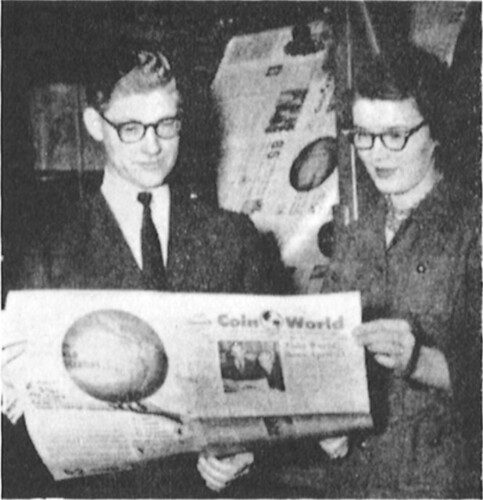
Coin World 1960 Copyright photo, published by permission.
I am shown in photo with my wife, Shirley, who was the second employee of Coin World. An experienced newspaper woman, she was the former TV and Church Editor of the Kansas City Kansan. I had met her there but months went by before I got up the nerve to ask her for a date.
I was hired as a salesman in the classified ad department of the Kansan a daily newspaper, and within a year I had been promoted to Classified Advertising Manager with a staff of three outside salesmen and eight inside lady phone operators.
When the invitation came from Amos Press to come to Sidney, Ohio, and start a weekly coin newspaper I had, by then, experience in numismatics and newspaper publishing in all departments, editorial, advertising (both display and classified) and circulation. I was single at the time and asked Shirley to marry me and move to Sidney, to start a new venture, a new life, and a new coin publication.
As a classified ad manager at the Kansan I would day-dream by writing classified ads of imaginary coin dealers. When I started Coin World I reserved the classified ads for myself and would process hundreds of these every week. I had invented a Classified Schedule for an intelligent arrangement of these.
This was a first in Coin World as well as Coin World being the first weekly newspaper for the coin field. While Numismatic News had existed prior to the first issue of Coin World -- and had classified ads -- they were all a jumble with no rationale of order. By placing related ads together under topics in a logical order it made quick reference to desired ads for readers.
I took further pride in getting big names in numismatics as advertisers and as writers -- many of these I had met previously as I had attended coin conventions for years prior. I got Hans Schulman as a weekly columnist, for example. Later, I got John Ford Jr, to submit an article, he rarely did this for any other publication. Eric Newman contributed an article for our first special issue, on the centennial of the Civil War, we covered the numismatics of that period. It was the first of many special issues.
Perhaps I should let E-Sylum readers read more of the story of how Coin World got started in the April 5 issue and not reveal too much here.
KRAUSE PUBLICATIONS
Krause Publications changes its three tabloid magazines – Numismatic News, Bank Note Reporter, and World Coin News – to a traditional magazine size, starting with the April 13 issue of Numismatic News and the May issues of Bank Note Reporter and World Coin News.
Our page size may decrease a bit but we will make up for it by increasing our page count. Our loyal readers will still get all of the great news, features and columns they've come to expect.
The new page configuration allows us to print more color pages. That means vibrant stories featuring coins and bank notes and compelling advertisements.
The traditional magazine size now allows us to "co-mail" the magazines, which means faster delivery to the East Coast and West Coast. No more delays in receiving your favorite magazines!
MORE ON THE 1872 J.F. BELL PROOF EAGLE
Regarding Pete Smith's query about the 1872 Proof Eagle $10 gold coin in the RARCOA J.F. Bell sale, Bill Rau supplied this scan of the auction catalog page. Thanks!
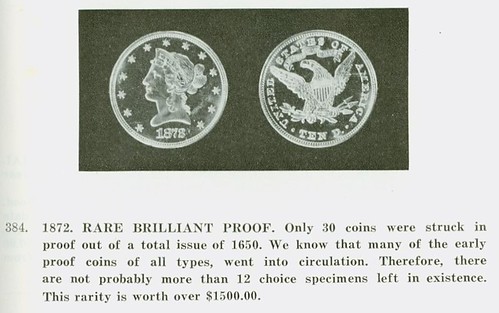
Scott Rubin forwarded the text of the description and adds:
The coins sold for $1175.00.
A FRENCH COIN CABINET C1809-19 BY JACOB-DESMALTER
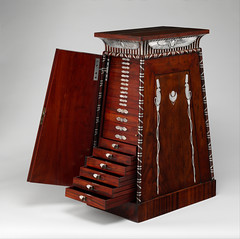
Dominique Vivant-Denon was director of the mint and of the Musée Napoleon (now the Musée du Louvre) as well as a collector and an arbiter of taste during the Napoleonic period. He accompanied the Egyptian campaign of 1798–99 as a draftsman and published his drawings as Voyage dans la basse et la haute Egypte (1802).
The pylon at Ghoos, in Upper Egypt, served as the model for the top section of this medal cabinet, which was intended for Napoleon but remained in Denon's possession. The front and back panels are inlaid with a silver scarab flanked by uraei (sacred serpents) on lotus stalks. There are twenty-two drawers on each side of the cabinet, all inlaid with a silver bee. One wing is hinged to provide a pull.
To read the complete object description, see:
Coin Cabinet
(www.metmuseum.org/works_of_art/collection_database/european_sculpture
_and_decorative_arts/coin_cabinet_francois_honore_georges_
jacob_desmalter/objectview.aspx?page=1&sort=0&sortdir=asc&keyword=
medal%20cabinet&fp=1&dd1=12&dd2=0&vw=1&collID=12&OID=120010265&vT=1)
To read the earlier E-Sylum article, see: QUERY: 1872 J.F. BELL PROOF EAGLE LOT DESCRIPTION SOUGHT (www.coinbooks.org/esylum_v13n12a16.html)
NOTES FROM E-SYLUM READERS: MARCH 28, 2010
Last week's experiment with character formats was a qualified success. Many readers reported that the troublesome characters were now displaying properly for them, including Jim Duncan, Ray Williams, Ron Greene, Ken Berger, Chris Hopkins, Bob Merchant, Yossi Dotan, Nick Graver, Allan Davisson, and Joe Boling.
But it wasn't smooth sailing for everyone. David Gladfelter and Alan Meghrig had some problems. Alan is on a Mac; he has offered some advice and I'll follow up with another test. Thanks, everyone, for your patience.
I don't think I published this query in The E-Sylum, but a reader inquired about Proof 1909 cents in the Chapman sale of the Jenks collection. I asked Dan Hamelberg who writes:
There were no single lot 1909 proof cents in the Jenks sale, but there were two lots where 1909 proof cents were included. Lot 6295 contained 14 proof cents and included 1909 cents with and without VDB. The lot sold for 5 cents.....9 cents below face value! Lot 6357 was an 1909 proof set which included the 1909 Lincoln's with and without VDB. It sold for $1.60 (93 cents face value).
Numismatic Guaranty Corporation (NGC) Research Director Dave Lange writes:
I wish I could be at the EAC/JRCS gathering to hear the programs by Dave Bowers and by Len Augsburger and Joel Orosz. I'm particularly excited about the new Mint history book, and it was interesting to see the photo of Stewart's building being demolished. The wholesale destruction of many square blocks of downtown Philadelphia in the 1960s to make way for the quite sterile Independence Mall was a tragedy surpassing the magnitude of the original mint structure's loss in 1911.
I was reminded of this when I and some fellow NGCers hiked toward the waterfront following last fall's Whitman Expo in Philadelphia. Aside from the new mint itself, Independence Hall and the Liberty Bell, there is almost nothing to draw the eye in that part of the city. The area looks like a museum dedicated to the concrete and glass industries. A similar gutting occurred to Boston around the same time, and it's a sad reminder of how little our architectural and social heritage was valued in the 1960s era of Urban Renewal.
On the topic of printing in New Amsterdam (early New York) David Gladfelter writes:
Probably not. The following is from page seven of Isaiah Thomas, The History of Printing in America, with a Biography of Printers & an Account of Newspapers, 3rd ed. Edited by Marcus A. McCorison (New York, Weathervane Books, 1970). The original edition was published in 1810. “Except in Massachusetts, no presses were set up in the colonies till near the close of the seventeenth century. Printing then was performed in Pennsylvania, ‘near Philadelphia,' and afterward in that city, by the same press [William Bradford's], which, in a few years subsequent, was removed to New York.
The use of types commenced in Virginia about 1681; in 1682 the press was prohibited. In 1709, a press was established at New London, in Connecticut; and, from this period, it was gradually introduced into the other colonies; as well as into several of the West India islands, belonging to Great Britain.”
Joe Boling writes:
I am impressed that the obituary title for Peter Vottima included the word "numismatist." I wonder how any readers among the general public recognized it. Fortunately, for those who did not, the content of the obituary pretty well defined it for them.
Joe adds:
So where is the hole in the Eid Mar coin? It must have been repaired - I don't see it in the photos you published. Well, hell, I went to the linked article, and the coin there is completely different - not even from the same dies. Are you showing the one purported to be a counterfeit? Or is yours one of the silver ones, with a golden cast imparted by digital gremlins?
Regarding the portraits of Queen Elizabeth, Joe writes:
1960 was not the first year that a British monarch appeared on British paper money, or even on a £1 note. Not counting the scores of colonial and dominion notes that had portraits of the monarchs, George V appeared on homeland notes from WWI into the '30s.
I had concluded that the Bank of England was talking about notes issued by the bank itself when they said that such a portrait did not appear until 1960. (The earlier emissions were treasury notes.) I thought that the bank should not be so parochial in its writing. Then I went to the linked article, and found that the information did not come from a Bank of England press release at all - but from some commercial London website, written no doubt by someone who was born after 1960. THAT source needs better fact checkers.
QUERY: WAS GILBERT STUART SKETCH THE MODEL FOR DRAPED BUST COINAGE?
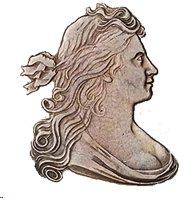 Famous American artist Gilbert Stuart painted many of our founding fathers and their wives, and his works have been copied onto American currency, commemorative coins, presidential dollars, first spouse coins, and state quarters. I am trying to document these colorful connections for publication. Yet one of his finest impacts is possibly the most difficult to verify, since the artwork in question has not survived.
Famous American artist Gilbert Stuart painted many of our founding fathers and their wives, and his works have been copied onto American currency, commemorative coins, presidential dollars, first spouse coins, and state quarters. I am trying to document these colorful connections for publication. Yet one of his finest impacts is possibly the most difficult to verify, since the artwork in question has not survived.
Numismatic scholars have debated Stuart's involvement in the introduction of the Draped Bust design that graced seven denominations of our early coins, starting with the 1795 silver dollar. I have found long descriptions of Anne Bingham's life (including an 1787 portrait and 1785 sketch of her by Stuart), but only bits and pieces of her connection to our coinage:
Former Mint Director John Ross Snowden in his 1861 work A Description of the Medals of Washington stated “The head of Liberty on the dollar of 1795 was designed by Stuart, the celebrated portrait painter, at the request of the Director (Henry DeSaussure), as we learn from a relation of the (Stuart) family…”
Some scholars declare that most early mint history is speculation and lore; because little was officially recorded. David Bullowa argued in The Numismatist in March 1942 that “In the course of the years since Snowden's work was published there is apparently no other mention of the Stuart connection with our coinage… (it) does not appear to be factually substantiated.”
In his 1966 book The U.S. Mint and Coinage, Don Taxay also cites Snowden's passage, and then adds “Mint Director De Saussure … engaged Gilbert Stuart, the renowned portrait painter, to redesign the Liberty head...”
Walter Breen expands on Snowden's description above in his 1988 Complete Encyclopedia of U.S. and Colonial Coins to add that Mint Director DeSaussure “induced the illustrious portraitist Gilbert Stuart to furnish a sketch of Ms. Liberty; this drawing (completed about Aug. 1795, in Newport, R.I., but now lost) was modeled after Mrs. William Bingham, nee Anne Willing.”
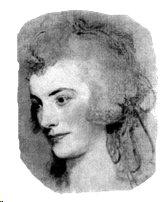
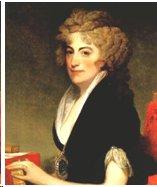
Other writers hedge their bets. Cornelius Vermeule reports that “Scot produced a new concept under the inspiration, it is said, of Gilbert Stuart.” (Numismatic Art in America, 1971.) David Lange writes “the design for this (draped bust) coin was reportedly furnished by famed American painter Gilbert Stuart, ... Unfortunately, no correspondence exists to confirm this appealing tale.” (History of the United States Mint and Its Coinage, 2005.)
Collector Reid Goldsborough maintains a website on draped bust coins and their connection to Anne Bingham at http://home.comcast.net/~reidgold/draped_busts/intro.html. He cites many of the same references above, and reports that Q. David Bowers has taken a neutral position on this issue. In his 1993 book Silver Dollars and Trade Dollars of the United States: A Complete Encyclopedia, Bowers says that Robert Scot "may well" have had Anne Bingham in mind when designing the Draped Bust Liberty, but this can't be proven with the documentary materials known today, and the discovery of further documentary materials is "highly unlikely."
R. W. Julian writes that “Not long into DeSaussure's tenure as director, the decision was made, almost certainly by the President, to change Liberty's head on the obverse. According to a later account, famed American artist Gilbert Stuart offered to execute sketches. (“All About the Dollar,” The Numismatist, December 2007.)
Red Henry strongly supported the Bingham links to Draped Bust coinage in his “The Girl on the Penny” article in Pennywise, January 15, 2000. His article was described in the Feb. 6, 2000 E-Sylum, but also claims that Henry was a distant relative of Anne Bingham!
Is there more to this story somewhere? Can an E-Sylum reader provide any other references?
THE BOOK BAZARRE
HISTORY OF THE CASINO CHIP & GAMING TOKEN COLLECTORS CLUB
Chip and token collectors have been around as long as casinos have, but it wasn't until the 1980's that collectors began talking with each other on a regular basis and dealers began to concentrate on casino material. Before the 1980's, chips and tokens could be found outside of casinos only as oddities: a few chips or tokens mixed in with a coin dealer's stock, or a few chips at an antiques shop or garage sale.
Two early chip dealers published short-lived newsletters, and a contributor to one of them was Archie Black, who lived not far from the relatively new casino gaming jurisdiction of Atlantic City, NJ. When the second of the two dealer newsletters ceased publication, Black, a chip collector with a long history of coin collecting and organizing coin clubs, decided to test the waters to see whether or not there might be sufficient interest to organize a chip and token collectors club similar to the coin clubs he had participated in. Late in 1987, Archie wrote to a number of collectors who appeared on the newsletter's subscriber list, inquiring about interest in an organized club.
The first issue of what would eventually become "Casino Chip & Token News", the quarterly magazine of the Casino Chip & Gaming Token Collectors Club at over 100 pages per issue appeared in January 1988, and was entitled “Atlantic City Chip & Token Newsletter.” The five page newsletter was the creation of Archie Black, who began publishing his newsletter quarterly including news and history of the relatively new (10 years old) Atlantic City casino industry.
The response to the survey Black included in his first issue was overwhelmingly in favor of establishing a formal club, and the Casino Chip & Gaming Token Collectors Club was a reality. The initial group of collectors numbered about 20, but the charter membership was extended to the first 100 members. That goal was passed immediately after the Club's first annual meeting at the American Numismatic Association convention in Cincinnati, Ohio, that July.
To read the complete article, see: THE LIVELY WORD OF COLLECTING CASINO MEMORABILIA (www.news-antique.com/?id=791324&keys=chips-tokens-casino-memorabilia)
For more information on the club, see: www.ccgtcc.com/
THE EMERGENCY MONEY COLLECTOR, VOL. 1 NO. 4
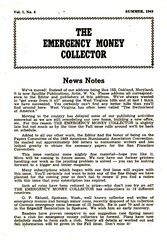 Arlie announces he has moved to West Virginia and his address is Spotlite Publications, Artie, W.Va. (Just for fun, I Googled on “Spotlite Publications” and found that Arlie's papers and documents are archived at Duke University.) Arlie comments on his work load. He just finished serving on the Papers Committee for the 1949 ANA Convention in San Francisco. As such, he prepared and mailed 500 letters to prospective authors.
Arlie announces he has moved to West Virginia and his address is Spotlite Publications, Artie, W.Va. (Just for fun, I Googled on “Spotlite Publications” and found that Arlie's papers and documents are archived at Duke University.) Arlie comments on his work load. He just finished serving on the Papers Committee for the 1949 ANA Convention in San Francisco. As such, he prepared and mailed 500 letters to prospective authors.
Readers have proven receptive to the idea of an emergency money collectors club and plans have now been made. Nearly all the details have been worked out and will be announced in the Fall issue. I can't wait!
On the front page, Arlie announces that O.P. Eklund of Spokane, Wash., well known collector of emergency monies, recently disposed of his collection of German emergency coins because of ill health.
Josef Ulm, P.O. Box 20, Ried im Inkreis, Austria, has an ad offering a wide range of POW Camp currency from WWI and WWII. Also 10 different “rare bills” from WWII concentration camps for $20.00. Walter Funck, British Zone, Germany, has an ad to sell “The Greatest Collection of German Emergency Coins”.
The feature article is entitled “Paper Money of the Spanish Civil War” by Dr. Arnold Keller of Berlin. An interesting aspect of this were the competing emissions of the Spanish Republic and General Franco's forces. There was an immense multitude of emergency issues. In the province of Catalonia, alone, there were over 700 communities that produced their own notes. Spanish emergency notes also started being printed in the Catalan language in addition to Spanish.
Chapter II of “Russian Emergency Paper Money” by Wladimer M Oushkoff, is presented. The war gave impulse to inflation and by January 1, 1917, there were 9175 millions out. (Note the author never seems to use a denomination, which, I assume, would be roubles.) The Republic (!) in 1917 created new types of notes, while continuing to print the old types, too. In all, the Government issued about 12 billion Imperial notes and 123 billion Republican notes until September 29, 1922, when Imperial notes were redeemed and declared worthless. The year 1922 brought about change to address inflation. First was a new unit called the “Rouble-1922” equal to 10,000 old roubles. It appears to be no different that the old monetary unit and the purpose was to eliminate the need for zeros. Second, in1923, a new paper rouble was created that was equal to 100 Rouble-1922 notes or 1 million old roubles. There were few local issues because central Russia was so poor.
The magazine is now 12 pages long. Recall I speculated earlier that paying for foreign subscriptions and advertisements must have been more complex 50 years ago. Well, Arlie announces that those who cannot send money orders or U.S. currency can pay for their subscriptions and ads in exchange for “collectable emergency monies”.
To read the earlier E-Sylum article, see: THE EMERGENCY MONEY COLLECTOR, VOL. 1 NO. 3 (www.coinbooks.org/esylum_v13n12a17.html)
MORE ON SHIRJIEH PUBLISHERS AND COPYRIGHTS
Dick Hanscom writes:
Someone was trying to trace the owner of a publishing house, known to be deceased, but didn't know about his wife. I have used this source in researching Alaska token issuers: ssdi.rootsweb.ancestry.com/cgi-bin/ssdi.cgi .
It is the Social Security death index. Not perfect, but pretty good. It won't tell you where a person is if still alive, but if the person is dead, you can stop looking.
I should have written sooner. I can tell you just about anything you want to know on this subject because I have the papers of Ward D. Smith. These two "companies" had no physical existence. They were just names created by Ward Smith for the publishing of some books.
Shirjieh is certainly Chinese meaning "world" and Chenby is probably intended for "ch'ien pi" meaning coin or money. I don't know why Ward chose different names for the "publisher" of the books he produced -- perhaps it was to legally separate the assets of the books being published.
Ward Smith did file a copyright application for "Chinese Banknotes" -- I know this because there is a notice from the copyright office to him in 1971 saying that his original application was incorrectly filed out, and asking him to submit a new form. I presume he did so. That book would have been copyrighted under the old copyright law, which was only good for 28 years. So unless his widow renewed the copyright, it is now in the public domain.
Ward's widow is still alive, or at least she was in 2008 when I visited her. At that time I obtained some unsold copies of "Chinese Banknotes" (brand new, still in the original box from the printer) so it is not really out of print now (I have some for sale). In the 1980's I saw a pirated version of this book for sale in Hong Kong. I suspect the pirate version was printed in Taiwan because all the listings of communist notes had been removed.
Ward Smith also published the Sten catalog of world paper money --- one of the first attempts at such a listing. As stated in the book, the copyright for this work belonged jointly to Sten and a woman named there (actually his niece who lived in Poland). The first two volumes of this 4 volume set were published, and the other two volumes were either finished or very near finished. At that point Sten died unexpectedly.
He lived alone in an apartment. His housekeeper discovered the body and called the police. While the police were there, she began removing his paper money collection and the manuscript for the other two volumes -- telling the police that she was his wife. She disappeared and the last two volumes disappeared as well.
When he found out what had happened, Ward tried to get the police or the courts involved, but nothing could be done. I have a very thick file documenting the events and Ward's efforts to recover the collection and the manuscript, believing that both legally belonged to Sten's niece in Poland. All he was able to do was to send her some money from time to time as the Sten books sold and to send her the balance in a small account of Sten's for which he was holding the passbook.
Ward Smith also published the original Basso book on Philippine coins. There was one box full of this book at Ward's widow's house, which we bought in 2008. All of these (about 30 copies) went to a coin dealer in southern California whose name I can't recall at the moment.
George Sten wrote another book on world paper money before his two volume catalog. Published in 1965, this work was titled: "Encyclopedia of World Paper Money", and it was full of great information on world paper money. There were no actual listings of notes, just lists of issuing authorities, banks, charts with number systems, names of the months in various languages, translations of Chinese and Japanese bank names and so forth.
This was the outline for a larger work. It was published, spiral bound, by Universal Publishing Company of Port Washington (New York ?). There might have been two editions of this Encyclopedia. My copy has a 1965 copyright by Universal Publishing and a 1972 copyright by Joan Alexander (Box 7, Roslyn, NY 11576). I am unclear on how there can be two copyrights on the same book, but this is what is printed on the title page.
I believe there was an even earlier attempt at a catalog of world paper money. The same Universal Publishing Co. produced a thin paperback catalog about 1961, but I don't recall the author and I can't find my copy. This work and Sten's two volumes were probably the first published general catalogs of world paper money. Arnold Keller may have had a manuscript catalog at that time, but it was not published.
In the 1980's someone reprinted the two Sten volumes in one softcover book. I don't know who produced this reprint -- it isn't marked with any names except those in the original work.
To read the earlier E-Sylum article, see: MORE ON SHIRJIEH PUBLISHERS AND COPYRIGHTS (www.coinbooks.org/esylum_v13n12a12.html)
COPYRIGHTS AND THE E-SYLUM
Pete Smith writes:
Near the bottom of last week's E-Sylum is a reproduction of "Diecutting at the Mint, 1794", a painting by Marcia Bush. I have two problems with this.
1. You should have identified the image and the source.
2. A painting is covered under copyright laws like publications. Paintings should not be reproduced without permission.
I don't know if your source violated copyright laws. I believe that it is still illegal to publish such an image, even if the source is a website without a copyright notice.
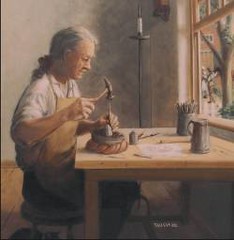
We've discussed this issue before, but it never hurts to review it. The quoting of text and reproduction of images in publications such as The E-Sylum is generally considered "fair use". Links to the location where the quoted material was found are always included. Web page links are generally listed and embedded directly in the E-Sylum email and archive pages; links for images are included in the description on our Flickr image archive.
In cases where I am quoting material directly from one of our sister hobby publications, the bar is set higher. As a potential competitor I need to tread more carefully, and usually ask for explicit permission in addition to simply citing the source. In the case of the Coin World photo used in this issue, I explicitly included the copyright notice preferred by Coin World.
For non-hobby publications I sometimes mention the source of images directly in The E-Sylum. Yes, I could and perhaps "should" do this for every image, but that is an unrealistic goal, especially when the found material is taken from a third source, as in the case of the Marcia Bush painting. Even if the original source is stated on the site I quote I rarely have the luxury of time to follow up before publishing.
This is a blog pulled together in bits and pieces of spare time and published for free. For thoroughly researched, annotated, edited and proofread articles, one must look elsewhere, such as Coin World and Numismatic News, where your subscription dollars pay for a qualified fulltime staff of professionals.
My only fact checkers are you, the readers. I can usually count on someone to set me straight when something is misattributed, as Pete just did in this case. When corrections arrive (usually within days), they are published for all to see in the next issue.
Should any quoted publication object, I will publish a correction and remove the offending image from our archive. However, in over a decade of publishing The E-Sylum, this has never happened. The closest instance is when we purged an image of someone I quoted. I'd taken the image from a public web site but hadn't had time to confirm its use with the subject. When asked, we purged it.
Yes, copyrights are a can of worms. Our current practice seems to be working, but reader thoughts are always appreciated. Thanks, Pete.
To read the earlier E-Sylum article, see: FEATURED WEB PAGE: BIOGRAPHICAL SKETCHES OF LARGE CENT PERSONALITIES (www.coinbooks.org/esylum_v13n12a29.html)
MORE ON THE STOLEN VALOR ACT OF 2005
The editorial on Stolen Valor states:
If Congress can criminalize such claims, it could make half of the pick-up lines used in bars across the country crimes. It could theoretically criminalize other false claims from architects to accountants to anthropologists.
The clearest sign that this statement is a bit extravagant is the fact that Congress criminalized such claims a long time ago, 87 years to be precise. The Act of February 24, 1923 (42 Stat 1286) punished the unauthorized wearing, manufacture or sale of War Department medals by fine and imprisonment. Any ensuing harm to architects, accountants, or anthropologists would surely have been noticed by now.
First Amendment rights are important, but they have limits; they have never protected counterfeiting, trademark infringements, or impersonation of military personnel. Of course, wearing a false medal may not seem like an actual fraud, but circulating false currency might not seem like a fraud either. In both cases, however, the victims are the holders of the real things which lose a little of their value with every false one out there.
In 1923, Congress felt that it had to protect the value of the medals it issued and that existing laws were insufficient. (Curiously, decorations of allied countries had been protected since 1918). Most countries have long criminalized counterfeiting the honors they bestow, because they are just as vulnerable as fiat money. One could debate whether Congress should be issuing such baubles at all; but if it is, it stands to reason that it would protect their value.
As with fiat money, of course, a government can debase its own honors by issuing too many; certain European countries have been rather profligate in this respect as in others.
To read the complete article, see: STOLEN VALOR: AN EDITORIAL (www.coinbooks.org/esylum_v13n12a24.html)
A COMPULSIVE COLLECTOR: COIN HOARDS IN IRAN AND PAKISTAN
Bruce Smith writes:
I am attaching something I retyped from a book in my library. It's about an American working for the Ford Foundation in Iran and Pakistan in the 1960's, and his experiences with coin hoards and coins sold in local markets there. It's from Chapter 28: A Compulsive Collector.
Fifty Years Around the Third World: Adventures and Reflections of an Overseas American, by Haldore Hanson. Fraser Publishing Company, Burlington, Vermont 1986. ISBN 0870340808 (paperback) 0870340816 (hardcover).
My favorite diversion during four years in west Africa was collecting tribal art, especially wood carvings. And in south Asia my passion was ancient coins. ……. In the Iranian Khuzestan, as mentioned earlier, our land-leveling machines inadvertently tore open ancient graves that contained relics, including clay pots of coins.
Most coins were Elamite --- 2,000 to 2,500 years old, a quarter inch in diameter, usually depicting a bewhiskered Elamite king with a star and crescent over his crown. No one else in our organization was interested in coins, so our laborers gladly accepted from me a few modern rials for each handful of old coppers. In two years I collected 3,000 specimens.
Later in Tehran, I found jewelry shops with silver coins of Alexander the Great --- the drachma, size of an American dime, and the tetradrachma, the size of an American half dollar. (Alexander lived from 356 to 323 BC). Tehrani jewelers melted down these Alexandrians to make modern jewelry for Iranian women, so it was possible to buy coins by the ounce for the current price of silver bullion. I bought about 100 silver pieces at prices that ranged from US 10 cents to US $1.00 each. Their true value has no doubt by now been discovered.
In Pakistan my coin collecting was again stimulated when I visited Taxila. Taxila is an old capital of Alexander the Great, located about 20 miles northwest of modern Islamabad. It is now a ruin of foundations a quarter mile square, located on a slight rise. There is a small museum there, but something more important to me -- farmers who till the surrounding fields constantly discover coins in the soil. If a visitor were to stand for a few minutes on the front steps of this ancient site, a farmer would walk from the fields, draw from his pocket a folded rag and display a small collection of ancient coins, usually a mixture of silver and copper. I never saw a gold coin here although gold coins existed in Alexander's day.
In Pakistan jewelry stores at Peshawar and Lahore, I found collections of Alexandrian drachma, all green with patina and looking truly ancient. But when I cleaned some of them with acid, I discovered they were reproductions, cast by the same jewelers who sold them. I asked one jeweler how he produced the green oxidation. Easy, he said. He had pushed the dime-sized coin down the throat of a chicken; when the coin came out with the droppings, the acid of the intestinal tract had caused the green color.
On my last visit to Taxila -- just before the end of my Pakistan assignment -- a village boy showed me some exciting silver coins, and I offered to buy them all. Then it occurred to me to ask if he had others. Yes, he said, he had a hoard at his home. We drove to his village a few miles distant, and there he produced a lump of coins, the size of a grapefruit, mostly coppers stuck together.
We had no time to break them apart and count them because my plane was about to depart from Rawalpindi. How much did he want? He said 10,000 rupees, which was probably the largest sum he could imagine. I gave him a one thousand rupee note (US $140), and he jumped with joy. That hoard still sits in a closet drawer awaiting my retirement and an appraisal of their value. I don't think they are fakes, but they may be.
Bruce adds:
Haldore Hanson (1912-1992) was in Iran during 1959-1962 and in Pakistan 1962-1967, working for the Ford Foundation as an agricultural consultant. During the 1930's he was a foreign correspondent in China. Early in 1942 he was hired by the U. S. State Department to set up a program to send American experts in cultural, technical and scientific fields to China to teach classes and provide technical assistance. Hanson, himself, however, ran the program from Washington, DC.
After the war, Hanson worked for the Ford Foundation on development programs in Burma, Iran, Pakistan, Bangladesh, Nigeria and Mexico. During the 1970's and 1980's, Hanson ran a Rockefeller Foundation program in Mexico called the International Maize and Wheat Improvement Center, developing hybrid grains for use in different parts of the world. Did anyone know Haldore Hanson or know about his collecting? Was he a serious collector? Did he belong to any numismatic organizations? Did his collection ever come on the market? The book from which these passages come is his autobiography. Photos in the book show him shaking hands with the last Shah of Iran and in Yenan during a 1983 trip to China.
In the late 1930's as a journalist, Hanson had visited Yenan, the capital of the communists in China, and met Mao Tse-tung and others, as well as Canadian doctor, Norman Bethune. In the early 1950's Senator Joseph McCarthy wrongly accused him of being a communist, and persecuted him along with many others during the shameful anti-communist hysteria McCarthy created during those years.
THE BOOK BAZARRE
NEWSPAPER ARTICLE PROFILES NUMISMATIC WRITER ED REITER
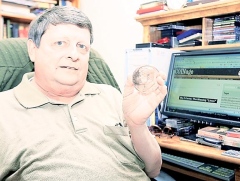 Scrounging beneath couch cushions doesn't suit Ed Reiter.
Scrounging beneath couch cushions doesn't suit Ed Reiter.
No, his hobby of coin collecting was a humble pursuit, a way to handle metallic pieces of history with their tale of how they were designed and struck by mints. The farthest the 72 year old ever went in hunting for rare pieces of spare change was cashing $25 of his paycheck to mine rolls of change for his quarry.
Reiter may have been a lightweight to his peers in Numismatics, as the hobby is officially known, but he found another way of holding their attention. For 40 years, the journalist has quietly documented and commented on all matters tied to coin collecting as a newspaper columnist whose insights earned him weekly spaces in The Asbury Park Press, The Bergen Record in New Jersey along with The New York Times.
These days, the Nanticoke resident pens a modest monthly column in COINage, a magazine dedicated to topics such as reviling the use of manganese in the Sacagawea gold dollar.
"What I try to do is write for the reader who doesn't even collect coins," Reiter said. "Everybody has an interest in money. There's no point in getting so technical that you turn 90 percent of people off rather than bringing them into the subject."
Selling people on taking an interest in the loose change jangling in their pockets started in 1973, when Reiter approached an editor at the Park Press with the idea of column. There was one for gardening, why not coins? Over six years, he went to local meetings of coin-collecting clubs and wrote pieces he thought received some passing attention.
"It was journalism first and coins second," he said. "Now, it's both."
In one column, he lambasted a new design on the back of the cent piece, and in his latest considers plans to honor national parks on the reverse sides of quarters to be ludicrous. How are you going to represent an entire expanse of land on a canvas so small, he wonders.
"I've become sort of a grouchy old man in the eyes of some readers and the U.S. Mint," he said. "Theoretically, since I write for a hobby magazine I should be upbeat, but I still think it's my duty to say what I think."
And he still loves Buffalo Nickels and the Liberty Quarter, showing a Lady Liberty wielding a sword and shield to ward off foreign enemies who would threaten U.S. isolationism on the eve of World War I.
To read the complete article, see:
Nanticoke man combines love of writing, coins
(citizensvoice.com/arts-living/nanticoke-man-combines-love
-of-writing-coins-1.691382)
FIRST EVER VICTORIA CROSS MEDAL TO BE SOLD
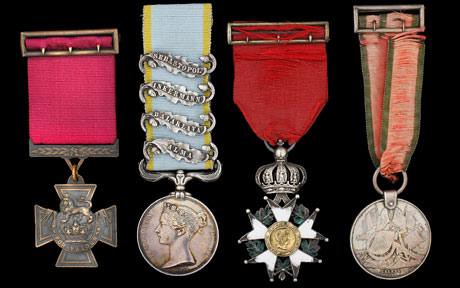
The first ever Victoria Cross medal awarded to a soldier of the British Army is expected to sell at auction for £120,000.
It will be sold along with the cannon ball that blew off the brave soldier's arm off.
The incredibly rare medal was awarded to Major John Simpson Knox by Queen Victoria on June 26, 1857, for his exceptional heroism during the Crimean war.
He lead troops in in Alma, Sebastopol, Balaklava and Inkerman between 1854 and 1856, the first few engagements to be considered for a VC.
Medal Specialist Oliver Pepys said the medal was of massive historical importance.
He said: "This is the first Victoria Cross ever handed to a soldier of the British army.
He lead troops in in Alma, Sebastopol, Balaklava and Inkerman between 1854 and 1856, the first few engagements to be considered for a VC.
Medal Specialist Oliver Pepys said the medal was of massive historical importance.
He said: "This is the first Victoria Cross ever handed to a soldier of the British army.
The medal goes on sale at Spink Auction House in London on April 22 and is expected to sell for a staggering £120,000.
It is being sold alongside three other medals Knox was awarded, the Crimean Medal, the French Legion of Honour and the Turkish Crimean medal.
Knox recorded his service and experiences in Crimea in a number of letters, copies of which he pasted into a scrap-book which were later found and published.
To read the complete article, see:
First ever Victoria Cross medal to be sold at auction
(www.telegraph.co.uk/news/newstopics/politics/defence
/7520764/First-ever-Victoria-Cross-medal-to-be-sold-at-auction.html)
JOHNNY SWING'S COIN FURNITURE

Johnny Swing, Nickel Couch, 2001
Nickels and stainless steel, 80 x 22 x 28 1/2 inches
Knoedler Project Space is pleased to present Johnny Swing, an exhibition of his sculptural furniture. Since completing his studies at Skidmore College and the Skowhegan School of Painting and Sculpture, Johnny Swing (born 1961) has been creating art for over two decades. Although he presently lives and works in Vermont, Swing spent the early years of his career working in New York City's eclectic East Village in the 1980s. Swing's furniture designs are on view at LongHouse Reserve in East Hampton; his Nickel Couch (2001) and Butterfly Chair (2002), works included in Knoedler's exhibition, are in the permanent collection of Storm King Art Center in Mountainville.
Taking common, everyday materials and austerely "repurposing" them, typically in a repetitive patterning, Swing has created unique examples of functional sculpted furniture. His designs have included works made from recycled baby food jars, and leather disks, remnants of Italian leather floor tiles. For his "coin furniture" series, Swing bundles steel rods and swirls them together to create the distinctively sinuous lines and dynamic curves of their armatures. Swing exclusively uses recycled—rather than newlyminted—coins, which he then polishes to a rich patina. His Butterfly Chair is composed of 1,500 welded half-dollars, and Nickel Couch of roughly 7,000 nickels, joined by 35,000 welds.
Swing's contemporary furniture designs have been included in The Chair, a review of the most innovative designs of recent decades. Nickel Couch was recently featured in The New York Times (on November 19, 2009), and in the December 2009 issue of Art & Auction magazine. His Chaise Longue, composed of welded quarters, was included in the Museum of Art and Design's 2008 exhibition, Second Lives: Remixing the Ordinary. Nickel Couch featured prominently in a 2008 installation at the American Museum of Finance, on Wall Street, and was recently reviewed by Christopher Mason, for the Times, as the "eye-catching pièce de résistance in Sotheby's auction of designer Robert Isabell's collection of "sublime oddities."
To read the complete article, see: Johnny Swing February 4–March 27, 2010 (www.knoedlergallery.com/project_space/current_exhibition/)
FEATURED WEB PAGE: IN GOD WE TRUST COURT OPINION
This week's Featured Web page is the March 11, 2010 opinion of the Ninth Circuit United States Court of Appeals regarding the use of the motto "In God We Trust" on U.S. coins and paper money. The court ruled against the plaintiff, Michael A. Newdow, who had argued the use of the slogan violated the U.S. Constitution.
This case calls upon us to decide whether the national motto of the United States, “In God We Trust,” and its inscription on the Nation's coins and currency, violates the Establishment Clause of the First Amendment or the Religious Freedom Restoration Act of 1993 (“RFRA”), 42 U.S.C. §§ 2000bb et seq, or both. We hold our decision in Aronow v. United States, 432 F.2d 242 (9th Cir. 1970), forecloses both claims. Accordingly, we affirm the district court's order dismissing this case under Federal Rule of Civil Procedure 12(b)(6) for failure to state a claim upon which relief can be granted.
www.ca9.uscourts.gov/datastore/opinions
/2010/03/11/06-16344.pdf
